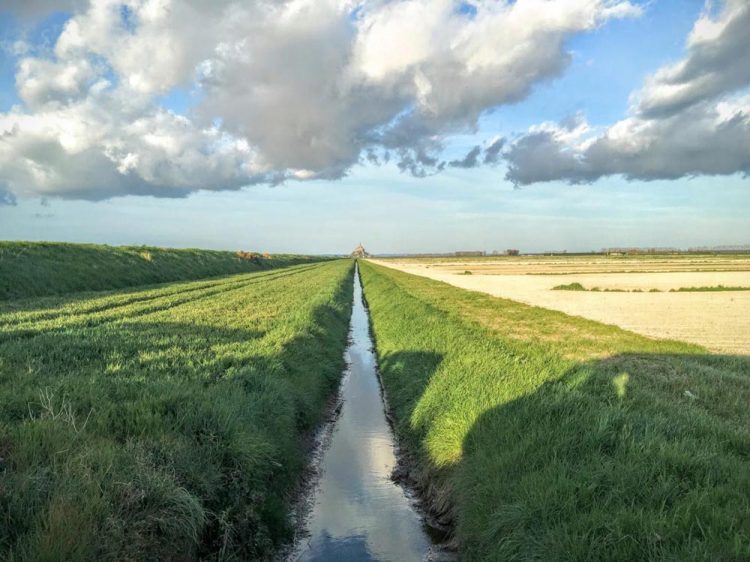Streams can be sensors

Scientists at Michigan State University have shown that streams can be key health indicators of a region's landscape, but the way they're being monitored can be improved. Credit: Photo by Ben Abbott
New research featured in Ecology Letters showcases how streams can be used as sensors to diagnose a watershed's sensitivity or resiliency to changes in land use practices, including the long-term use of fertilizers. Using streams as sensors – specifically, near the headwaters – can allow scientists, land-use managers and farmers to diagnose which watersheds can be more sustainably developed for food production, said Jay Zarnetske, MSU earth and environmental scientist and co-author of the study.
“We were surprised to see that the streams were good sensors of long-term nutrient conditions,” he said. “Our methods show that we can learn much from a relatively small number of samples if they are collected more strategically than current watershed management practices dictate. This understanding is critical in protecting aquatic ecosystems and ensuring human water security.”
Human activity, especially agriculture, has polluted freshwater ecosystems across the planet, causing massive ecological and economic damage. Excess nutrients from fertilizer and fossil fuel can trigger toxic cyanobacteria blooms and expansive hypoxic dead zones, undermining the capacity of ecosystems to provide the food and water that sustains human societies, Zarnetske added.
For the study, Ben Abbott, formerly at MSU and now at Brigham Young University, led an international team in a culturally and historically important region of France. The area, which has seen nearly a millennium of agricultural activity, serves as a model as to how increasing use of nitrogen and phosphorous fertilizers are having lasting impacts on watersheds.
“The manipulation of phosphorous and nitrogen in the landscape is one of the greatest threats to the fate of humanity and the rest of life on this planet,” Zarnetske said. “Most people have no idea that the human manipulation of the phosphorous and nitrogen cycles is occurring, is affecting nearly every place on the planet and is one of, if not the greatest, current threat to the fate of humanity.”
There are dramatic aerial photos of algal blooms growing at the mouth of streams flowing into bodies of water, such as Lake Erie. However, most carbon and nutrients enter waterways upstream, at the headwaters. So rather than try to diagnose problems at the mouth, a more efficient way to address the issue would be to sample many areas closer to the headwaters.
“Basically, instead of standing in a large stream far from the headwaters and observing what flows past us through time,” Zarnetske said, “we illustrate that it can be much more informative to periodically travel around the region and grab samples from the smallest to the largest streams in the watershed.”
The team found that each small stream's chemistry fluctuated widely due to changes in temperature, water flow and other factors. There was order to the variability, however, as there was synchrony in the behavior of each small stream and its role in the chemistry of the larger river system.
“That was unexpected,” Abbott said. “Somewhat surprisingly, we found that a single sampling of headwaters any time of year provides a lot of information about where nutrients are coming from and where to target restoration efforts.”
Future research will apply these methods globally, to different agricultural watersheds and forested landscapes experiencing changing precipitation patterns. For example, Zarnetske will study headwaters in the Pacific Northwest and the rapidly warming and thawing landscapes in the Arctic.
The new methods also can help direct efforts in selecting the most appropriate locations for sustainable agricultural land and development or identifying watershed responses to global warming, such as those in the Arctic.
Arctic landscapes, where soils are predominantly frozen, are rapidly thawing due to rapid climatic warming. As Arctic ice and permafrost melt, they release sediment and nutrients into rivers and seas. While the effects of these increasingly turbid waters and nutrients are unknown, their new approach can develop a baseline to begin monitoring their impact.
###
Additional researchers from Université de Rennes and University François-Rabelais Tours made key contributions to this study.
Michigan State University has been working to advance the common good in uncommon ways for more than 150 years. One of the top research universities in the world, MSU focuses its vast resources on creating solutions to some of the world's most pressing challenges, while providing life-changing opportunities to a diverse and inclusive academic community through more than 200 programs of study in 17 degree-granting colleges.
For MSU news on the Web, go to MSUToday. Follow MSU News on Twitter at twitter.com/MSUnews.
Media Contact
All latest news from the category: Power and Electrical Engineering
This topic covers issues related to energy generation, conversion, transportation and consumption and how the industry is addressing the challenge of energy efficiency in general.
innovations-report provides in-depth and informative reports and articles on subjects ranging from wind energy, fuel cell technology, solar energy, geothermal energy, petroleum, gas, nuclear engineering, alternative energy and energy efficiency to fusion, hydrogen and superconductor technologies.
Newest articles

NASA: Mystery of life’s handedness deepens
The mystery of why life uses molecules with specific orientations has deepened with a NASA-funded discovery that RNA — a key molecule thought to have potentially held the instructions for…

What are the effects of historic lithium mining on water quality?
Study reveals low levels of common contaminants but high levels of other elements in waters associated with an abandoned lithium mine. Lithium ore and mining waste from a historic lithium…

Quantum-inspired design boosts efficiency of heat-to-electricity conversion
Rice engineers take unconventional route to improving thermophotovoltaic systems. Researchers at Rice University have found a new way to improve a key element of thermophotovoltaic (TPV) systems, which convert heat…



